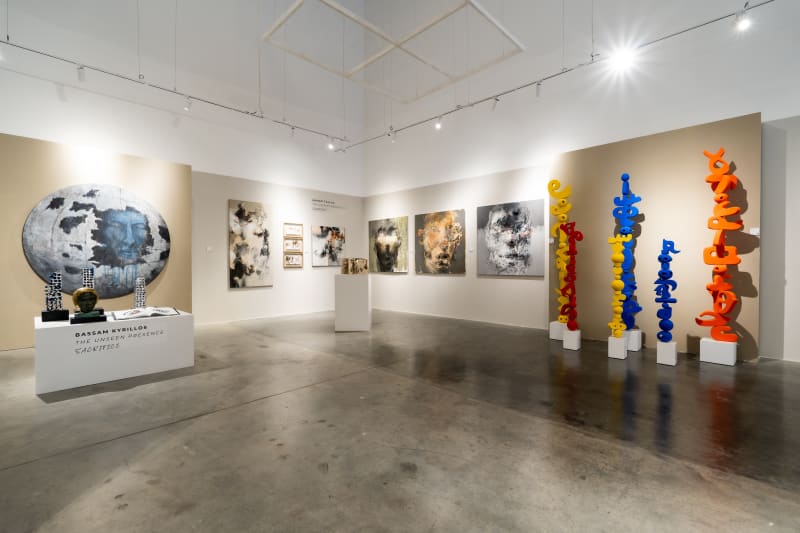"The sweetest homeland,
One can’t stand,
Living in such a homeland.
One can’t stand,
Dying in such a homeland."
— Nizar Qabbani, Balqis
Collective exhibition: Bassam Kyrillos, Besher Koushaji, Eyad Jouda, Hikmat Naeem, Ibrahim Hamid, Kamal Al Zoubi, Mahmood Al Daoud, Suheil Baddor, and Ahmed Talla.
Curated by Lina Mikati and Celine Azem
There are forces that shape us yet remain unseen—memories embedded in landscapes, histories etched into bodies, and the silent weight of loss carried across generations.
Inspired by Nizar Qabbani’s poem Balqis, the exhibition reflects on exile, war, and the irreversible shifts brought by displacement. Qabbani’s verses, which mourn not only a loved one but a homeland forever altered, resonate throughout the exhibition:
"The sweetest homeland,
One can’t stand,
Living in such a homeland.
One can’t stand,
Dying in such a homeland."
These words frame the paradox of memory—how longing and displacement coexist, how a place remains deeply cherished yet unbearably transformed. The Unseen Presence expands upon this idea, moving beyond mourning to explore the persistence of history in fractured realities, shifting identities, and evolving landscapes. Some works embrace nostalgia, while others question its fragility. Some reconstruct the remnants of a vanished past, while others examine the tension between survival and erasure.
Ahmad Tallaa and Suheil Baddor both investigate the emotional landscapes of migration, yet from different perspectives. Tallaa captures the unseen presence of comfort, depicting sanctuary as delicate and fleeting, where figures exist in liminal spaces caught between nostalgia and uncertainty. His muted palettes reflect the emotional weight of displacement, while moments of warmth suggest hope. In contrast, Baddor explores the unseen presence of waiting, portraying figures suspended in time, their identities in flux. His layered, abstracted compositions evoke exile as an unresolved state—where bodies are dispersed, and the search for belonging never ends.
Similarly, Ibrahim Hamid and Suheil Baddor focus on the experiences of displaced women, yet their artistic approaches diverge. Baddor’s unraveled figures mirror the instability of identity and memory, while Hamid preserves figuration, using bold brushstrokes to emphasize the emotional toll of displacement. Eyes serve as portals to silent narratives, revealing both grief and persistence. While Baddor leans into abstraction, Hamid balances it with realism, emphasising the endurance of those who carry not just personal loss but the weight of collective displacement.
Memory’s instability—both personal and collective—forms the foundation of Besher Koushaji and Hikmat Naeem’s works. Koushaji examines the unseen presence of memory, constructing portraits where faces emerge and dissolve, reflecting the way memories shift between clarity and erosion. His layered compositions speak to the fragility of identity in times of unrest. Naeem, in contrast, expands this theme beyond the human figure, exploring the unseen presence of lost cities, where architecture dissolves into abstraction. His textured compositions depict urban spaces on the verge of disappearance, with fading structures that evoke histories of war, migration, and erasure. While Koushaji focuses on how individuals carry history within them, Naeem reveals how cities, too, bear the imprints of time and loss.
Eyad Jouda and Bassam Kyrillos examine both physical and psychological endurance, though through vastly different media. Jouda’s wire-bound sculptures embody the weight of silence, balancing movement and stillness. His precariously poised figures convey the psychological strain of migration, where survival is a brittle equilibrium between resistance and surrender. Kyrillos, in contrast, delves into the unseen presence of sacrifice, merging human forms with architectural decay. His haunting imagery presents figures that appear to emerge from—and dissolve into—eroded buildings, embodying histories of suffering and survival. While Jouda’s sculptures evoke defiance through balance and motion, Kyrillos’ works channel destruction, displacement, and transformation through decay and fragmentation.
Mahmood Al Daoud also engages with destruction and renewal, but through a more organic lens. His work reflects the unseen presence of transformation, depicting cycles of erosion and rebirth. His layered textures reimagine memory as something that both disintegrates and persists, where ruination is not absolute but rather part of a larger process of reinvention. While Kyrillos anchors his work in the material decay of built environments, Al Daoud evokes the passage of time through abstraction, revealing how history leaves imprints long after physical traces have faded.
Unlike the other artists, Kamal Al Zoubi approaches nostalgia through a sense of playfulness, engaging with the unseen presence of nostalgia in a way that bridges past and present. His LEGO-Inspired Arabic Tower transforms childhood memories and linguistic traditions into sculptural forms, reinterpreting Arabic calligraphy through a contemporary lens. Where other artists explore nostalgia through decay, exile, and struggle, Al Zoubi preserves it through joyful abstraction. His work maintains a tangible connection to the past, where heritage is not something mourned but something continuously reimagined.
Through these distinct yet interconnected perspectives, The Unseen Presence invites audiences to witness what lingers in the aftermath—fractured realities, remnants of identity, and histories that refuse to fade. The exhibition asks:
What does it mean to rebuild from ruins?
How do we carry the unseen weight of history?
Can a homeland be reconstructed—not just physically, but through cultural and emotional memory?








